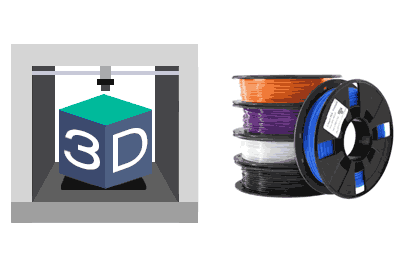We continue with the 3D printing section with this post about 3D printing materials.
In previous posts, we have seen the operation of an FFF 3D printer, its parts and components, and we have seen in detail the nozzle, the hotend, and the extruder.
Now that we have seen in detail the FFF printer and its operation, it is time to continue, and the next step is to talk about the materials we are going to use for 3D printing.
Of course, there is a wide variety of filaments and materials, and if we start looking at comparisons, we could end up dizzy and not understanding much.
So let’s make it easy. Your favorite materials for home printing will be PLA and PETG. They are your workhorses, your all-terrain vehicles.
Wait a minute, do you mean PLA and ABS? No, PLA and PETG. We will talk about the popular ABS at the end of this post, but, despite what you may have heard, currently ABS is not such a good option for 3D printing, with PETG as a substitute.
At the end of the post, we will also see other more “exotic” materials, less common and more difficult to print.
Of course, most materials are available in a multitude of colors. In principle, color does not (almost) influence the properties of the material. There are also semi-transparent materials that change color with temperature or sunlight.
PLA
PLA (Polylactic Acid) is a vegetable derivative, frequently from corn and sugar cane. Without a doubt, PLA is the undisputed king of 3D printing by filament and the most common within home printing.
PLA is easy to print, requires a low temperature, and hardly needs a heated bed (although it is convenient). The extrusion temperature is 190-220 °C, with a bed temperature of 45-60 ºC.
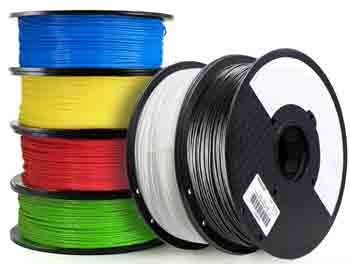
It has good bed adhesion and does not present deformations during printing. It also does not emit toxic vapors or odors. It is also an ecological and biodegradable plastic.
In terms of mechanical characteristics, PLA is considerably strong and hard, although somewhat more brittle than other plastics. That is, it withstands efforts quite well, is difficult to scratch, but is worse against impacts.
The biggest disadvantage of PLA is that, given its low melting point, it does not support parts that are subjected to thermal loads. PLA parts deform at temperatures above 60°C.
In addition, it cannot be used outdoors because it degrades under the ultraviolet rays of the sun. It also cannot be used to contain food. Finally, it is not resistant to water or chemical substances.
The cost of a one-kilogram spool is around 16-24€, depending on the manufacturer.
PETG
PETG (Glycol Polyethylene Terephthalate) is a variation of PET, a plastic widely used in the food industry to make containers such as bottles.
PETG is a very easy material to 3D print, as much as PLA. The extrusion temperature is 230-250 °C, with a bed temperature of 55-75º. It has good bed adhesion and hardly causes problems due to deformation during printing. It also does not emit toxic vapors or odors.
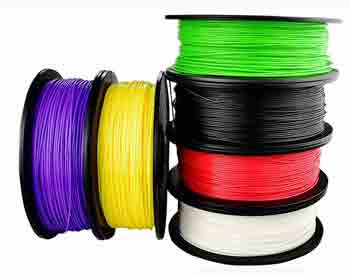
Mechanically, PETG has very good properties, even superior to the famous ABS. Compared to PLA, it is less resistant, softer, but tougher. That is, it possibly withstands lower tensions, is more easily scratched, but withstands impacts better.
It should also be noted that parts printed in PETG achieve excellent layer adhesion, which substantially favors its good mechanical behavior.
Unlike PLA, parts made in PETG are safe to be in contact with food. They also have better temperature resistance and can be used in outdoor applications. It is also difficult to ignite.
As a problem, PETG is a very hygroscopic material. If the material absorbs moisture from the environment, it can cause printing difficulties. Therefore, when not using the spool, it is convenient to store it in an airtight container.
As we can see, it is an all-terrain material and very suitable for 3D printing. The price is slightly higher than that of PLA, around 20-28€.
Other materials
Although we have presented PLA and PETG as our two favorite filaments, we could not talk about 3D printing materials without reviewing, even quickly, some of the other materials.
In general, all of them will have their advantages and disadvantages. But, they are certainly more difficult to print, due to deformations, adhesion problems, or requiring very high temperatures.
Use these materials only when you know
PLA Wood
It is a PLA to which a certain content of wood chips is added. It gives a very good appearance. The parts can be sanded to improve the finish.
It prints just like PLA, but it has a great tendency to cause obstructions in the hotend.
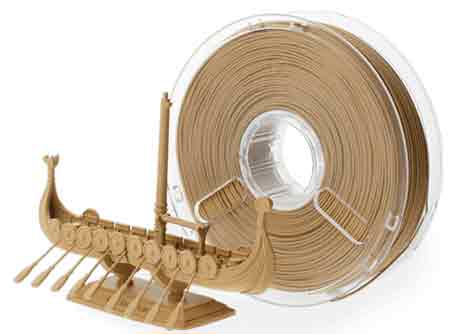
PLA Metal
It is a PLA to which a certain content of metal is added. The parts, when printed, are matte. But after sanding, they become shiny and have a very bright appearance.
It also prints just like PLA, but those metal particles can cause wear to the hotend.
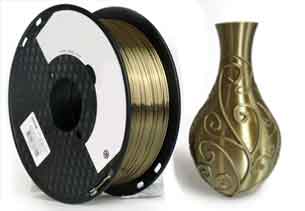
PLA Marble
It is a white PLA that alternates black color spots. The printed parts have a finish similar to marble, quite realistic.
In addition to the color variations, it is a normal PLA. There is no difference or additional problem compared to PLA.
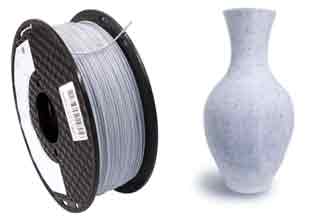
ABS (Acrylonitrile butadiene styrene)
ABS is a widely used plastic in engineering. It is a material with very good mechanical characteristics, especially it resists impacts very well. It is resistant to water, most chemicals, but is not suitable for outdoor use. ABS is printed at temperatures 220-250 °C and bed temperatures of 95-110 °C.
ABS has several disadvantages. On the one hand, it is quite difficult to print, presenting deformations (wrapping and layer delamination) during printing. In fact, it is advisable that the printer be closed to prevent air from reaching it. In addition, it emits (potentially toxic) vapors and odors, so it is not suitable for home use.
At the beginning of 3D printing, it was frequently used, but trust me, use PETG instead of ABS.
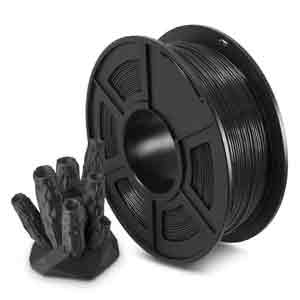
TPU (Thermoplastic polyurethane)
It is a plastic that has the property of being flexible. The printed parts are elastic and deformable.
However, it is somewhat difficult to print. In general, a direct type printer is necessary.
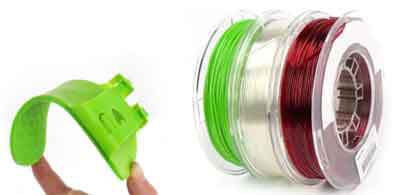
PVA (Polyvinyl alcohol)
It is a water-soluble material, so it is very convenient for making supports in printers with dual extruder.
It frequently replaces HIPS, which was a soluble material that required chemical agents to dissolve it.
It is somewhat expensive, and of course, it is highly hygroscopic, so it must be stored in an airtight container when not in use.
ASA (Acrylic Styrene Acrylonitrile)
It is a material similar to ABS in terms of mechanical characteristics, but with greater resistance to UV rays, so it withstands better in outdoor applications.
It is quite expensive and has the same problems as ABS in terms of difficulty of printing and emission of vapors and odors.
PC (Polycarbonate), PA (Polyamide), Carbon Fiber
We finish by putting all these materials in the “same category”. All of them have excellent mechanical properties, but they are extremely difficult to print.
We leave them there for now, because they are advanced materials and beyond the reach of most home printers.
Conclusion
We have seen the two main materials that we recommend using in 3D printing, the popular PLA and the all-terrain PETG. Both are available in a wide range of colors.
We have also briefly reviewed other interesting materials, although more difficult and recommended only for experienced users.
In the next post, we will continue to delve into 3D printing, looking at the parts of a 3D printed piece. See you soon!
